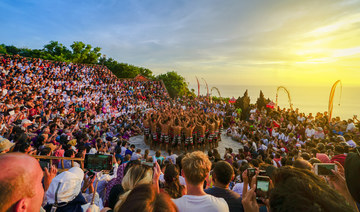LONDON: Homayoun Sakhi closes his eyes and runs his fingers along the long neck of his wooden instrument encrusted with mother-of-pearl.
“I feel like I have my Afghanistan in my hand,” says Sakhi, one of the world’s most renowned performers on the country’s national instrument, the rubab.
He is jet-lagged after flying in from California to perform at London’s Barbican concert hall to raise funds for emergency medicine and education in his homeland.
Along with the growing humanitarian crisis, Afghanistan’s rich musical culture is under threat as the Taliban have banned music since their return to power last year.
Widely shared videos have shown them smashing and burning instruments. Musicians have fled the country.
“Right now we don’t have music in Afghanistan,” says Sakhi.
“It’s really difficult because there are no concerts, there’s no music, and (for musicians) it’s very difficult to be without any money and without a job.
“That’s why they’re trying to go somewhere to play.”
The Taliban clampdown is a repeat of the hard-liners’ previous time in power between 1996 and 2001, when they banned music as sinful, under a strict interpretation of Islamic law.
The rubab dates back thousands of years and has enjoyed a revival thanks to Sakhi, who is known as a musical innovator and has developed a more modern playing style.
BBC Music Magazine called him “one of the greatest performers” on the instrument.
Born in Kabul, he left Afghanistan with his family in 1992, in the chaotic aftermath of the Soviet withdrawal, moving to Pakistan.
He later settled in Fremont, California, which is known for its large Afghan community, and has launched an academy teaching the rubab.
“Each time I’m playing, I’m home, I feel like I’m in Afghanistan,” he says.
Music including pop was allowed a free rein during the past two decades in Afghanistan, with local television even showing a “Pop Idol” talent contest equivalent.
But following the Taliban’s return to power, traditional Afghan music now relies on devotees overseas.
The “Songs of Hope” concert at the Barbican last Saturday was organized by Afghanistan International TV.
The London-based channel was set up by Volant media company, which also runs a Persian-language channel for Iranians.
It will screen a documentary about the concert in March.
In the first half, Sakhi plays classical Afghan pieces, followed by folk music that gets the audience clapping along.
He performs with UK-based virtuoso Shahbaz Hussain on tabla and Iranian musician Adib Rostami on the kamancheh, a bowed string instrument.
“I had the idea to do the concert — that was the only thing I can do as a musician,” said Rostami, one of the event’s organizers.
“As we know, now the music is banned in Afghanistan — they cannot ban this from the people around the world.”
“We have to try as musicians, as music lovers, to find a way to keep this cultural heritage for the future.”
The current situation for musicians under the Taliban is “back in the 1990s,” he says.
“Again, you cannot be a musician in Afghanistan.
“As far as I know, most of the musicians... are trying to get out of the country.”
A group of students and teachers from a national music school in Kabul arrived as refugees in Portugal in December, after the Taliban’s takeover earlier last year.
Afghanistan’s first all-female orchestra, Zohra, set up in 2016 and named after a Persian goddess of music, has moved to Qatar.
Virtuoso keeps Afghan music alive despite Taliban ban
https://arab.news/j6ury
Virtuoso keeps Afghan music alive despite Taliban ban

- Afghanistan's rich musical culture is under threat as the Taliban have banned music since their return to power last year
- "Right now we don't have music in Afghanistan," says Homayoun Sakhi
Moroccan director Asmae El-Moudir joins Cannes’ Un Certain Regard jury
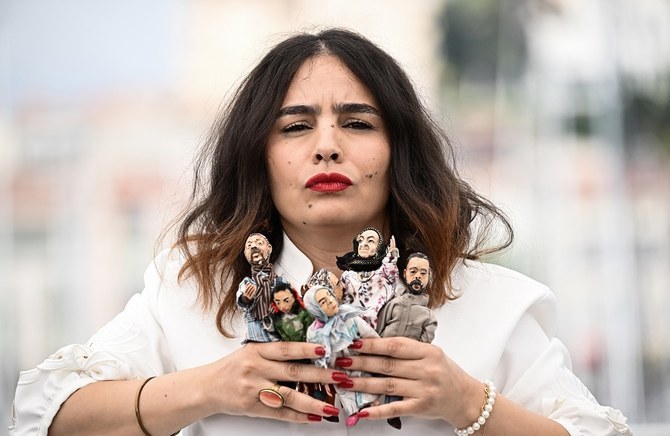
DUBAI: The Cannes Film Festival announced on Thursday that Moroccan director, screenwriter and producer Asmae El-Moudir will be part of the Un Certain Regard jury at the 77th edition of the event, set to take place from May 14-25.
She will be joined by French Senegalese screenwriter and director Maïmouna Doucouré, German Luxembourg actress Vicky Krieps and American film critic, director, and writer Todd McCarthy.
Xavier Dolan will be the president of the Un Certain Regard jury.
The team will oversee the awarding of prizes for the Un Certain Regard section, which highlights art and discovery films by emerging auteurs, from a selection of 18 works, including eight debut films.
El-Moudir is the director of the critically acclaimed film “The Mother of All Lies.”
The movie took the honors in the Un Certain Regard section, as well as winning the prestigious L’oeil d’Or prize for best documentary at the festival in 2023. The film explores El-Moudir’s personal journey, unraveling the mysteries of her family’s history against the backdrop of the 1981 bread riots in Casablanca.
El-Moudir is not the only Arab joining the Cannes team.
Moroccan Belgian actress Lubna Azabal this week was appointed the president of the Short Film and La Cinef Jury of the festival. The La Cinef prizes are the festival’s selection dedicated to film schools.
Second Ritz-Carlton Reserve in Saudi Arabia planned for Neom
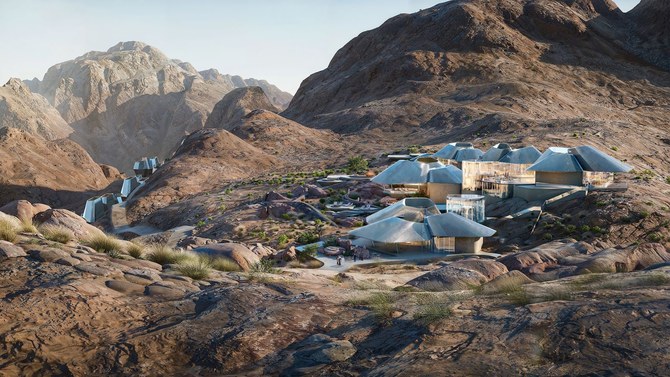
DUBAI: Marriott International, Inc. announced on Thursday that it has signed an agreement with Neom to open its second Ritz-Carlton Reserve in Saudi Arabia.
The hotel is anticipated to open in Trojena, a year-round mountain destination located in the northwest region of the country.
The resort is expected to feature 60 expansive one-to-four-bedroom villas. Plans also include a range of amenities including a spa, swimming pools and multiple culinary venues.
Chadi Hauch, the regional vice president of Lodging Development Middle East, Marriott International said in a statement: “Together with Neom, we look forward to bringing this ultra-luxury experience to Trojena. This signing also marks an important addition to our portfolio in Saudi Arabia where we continue to see a strong demand for our luxury brands.”
“Trojena is a rare destination, and we are delighted that Ritz-Carlton Reserve has hand-picked the mountains of Neom for their next property. Together we will create an experience that can’t be recreated anywhere else. Our visitors and residents will experience a sanctuary that will capture the magic of Saudi Arabia, embracing ultimate luxury in an unforgettable location,” executive director and Trojena region head Philip Gullett said in a statement.
Trojena, one of the flagship developments within Neom, is being developed and positioned as a year-round adventure sports destination that will include activities such as skiing, water sports, hiking and mountain biking. It will also include apartments, chalets, retail, dining, entertainment, leisure, sports and recreational facilities, and other hospitality offerings, including a W Hotel and a JW Marriott Hotel.
Ritz-Carlton Reserve currently boasts a collection of only six properties in destinations including Thailand, Indonesia, Puerto Rico and Mexico.
The Arab world at the Venice Biennale: Artists explore themes of identity, immigration, history
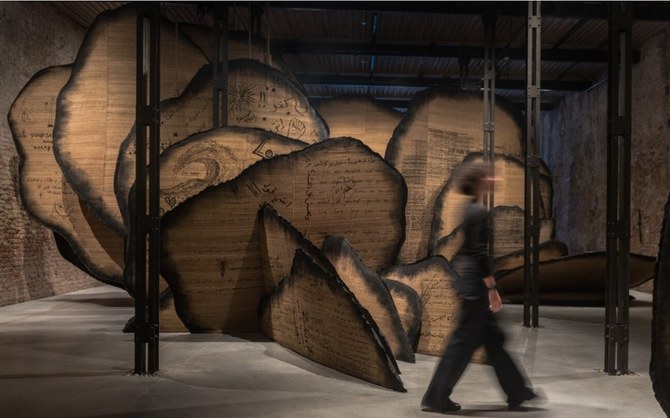
VENICE: No event in the international art scene is more anticipated, or debated, than the Venice Biennale. This year’s edition, “Foreigners Everywhere,” curated by Adriano Pedroso from Brazil, features 331 artists and 86 nations, including four Gulf countries as well as Lebanon and Egypt.
Saudi Arabia
Women’s voices chanting in unison fill the air of the Saudi Pavilion at Venice this year. “Shifting Sands: A Battle Song” was created by Saudi artist Manal AlDowayan, and hundreds of women from across the Kingdom participated in its creation. The exhibition, which includes large-scale installations in the form of desert roses filled with writing and drawings by the Saudi female participants whom AlDowayan worked with, aims to showcase the evolving role of women in the Kingdom while also striving to dispel media narratives that have long defined them. The chanting is derived from traditional battle songs once performed by Saudi men before they went into battle. Here they are chanted by women in a powerful chorus of strength and resilience, backed by recordings of the wind passing through sand dunes. The work, AlDowayan tells Arab News, “is about change, subtle changes — like those of a sand dune — the surface changes, but the core stays the same.”

UAE
Emirati artist Abdullah Al-Saadi is presenting “Sites of Memory, Sites of Amnesia” at the National Pavilion of the United Arab Emirates. It’s an introspective show consisting of drawings, sculptures, paintings and installations charting Al-Saadi’s travels around his homeland. “Traveling and understanding the natural world around me has always been an important part of my work,” Al-Saadi, who has even used rocks from the Emirates as his ‘canvas’ for some of the works, told Arab News. “Through this presentation in Venice, I hope visitors will enjoy tracing the travels I have taken over the past few years and also think about the world around us, and our place within it.”
Visitors will also be presented with gifts: maps and scrolls in colorful traditional chests from the region, which will be removed and presented to guests by actors from the UAE.
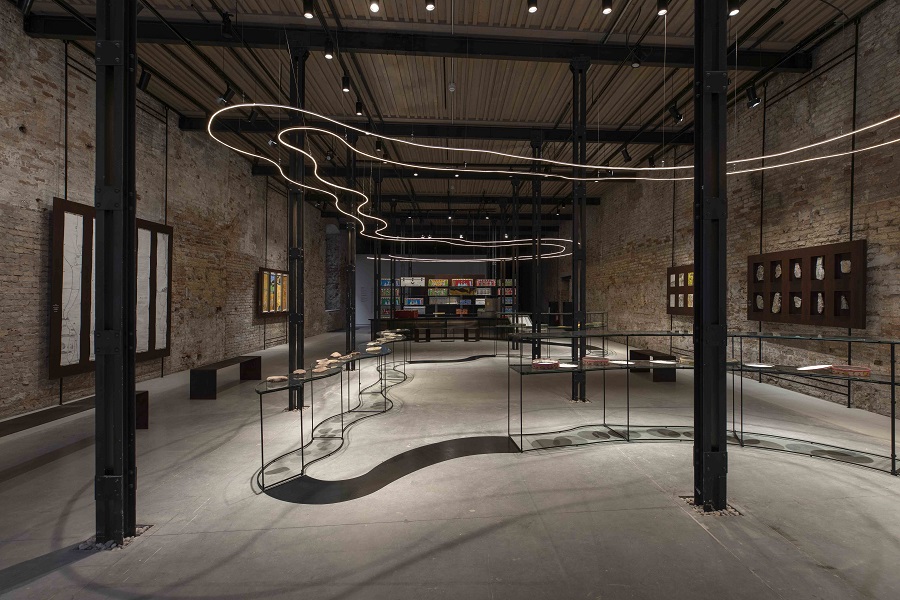
Qatar
While Qatar doesn’t have a national pavilion at the biennale, it is presenting “Your Ghosts Are Mine: Expanded Cinemas, Amplified Voices” — a group show of films by artists from across the Arab world, Africa and South Asia, as well as video installations from the collections of Mathaf: Arab Museum of Modern Art and the Art Mill Museum (scheduled to open in 2030). All the films were backed by the Doha Film Institute.
“For me, it was important to show movies reflective of the theme of the biennale — so, revolving around immigration, foreigners, personal diaries and self-portraits and stories from women — all coming from independent (artists) in the Global South, whose voices are not always shared,” the Paris-based curator Matthieu Orlean told Arab News.
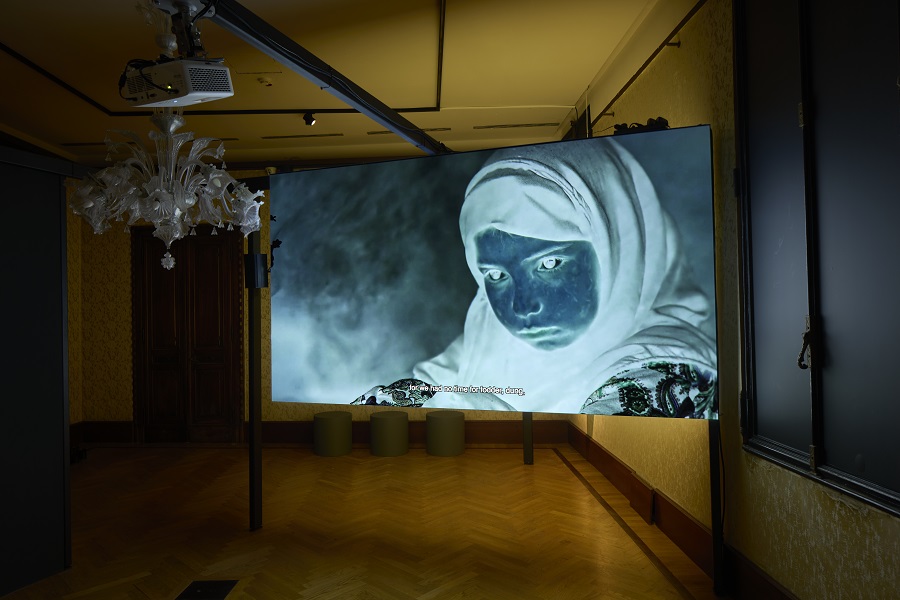
Egypt
Alexandrian-born artist Wael Shawky has created “Drama 1882,” a 45-minute film for which he also composed the music, for Egypt’s national pavilion, which — in the first week of the biennale at least — has proved to be one of the most popular pavilions at this year’s event.
The film is based around Egypt’s nationalist Urabi revolution against imperial influence in the late 19th century and Shawky uses historical and literary references as starting points from which to weave together a story that fuses fact, fiction and fable, while also exploring national, religious and artistic identity.
“I worked with performers who enacted a play in a theater for the film,” Shawky told Arab News. “The film strives in part to connect the idea of history to drama — drama regarding the connection to catastrophe and drama regarding cynicism. I like to analyze the authenticity of history, especially Egyptian history. When one makes films about history there is this gap between truth and myth.”

Lebanon
Lebanese artist Mounira Al-Solh’s multimedia installation “A Dance with Her Myth” combines drawing, painting, sculpture, embroidery, video, and audio, and guides viewers through ancient Phoenicia. The piece, Al-Solh explains to Arab News, is inspired by the tale of Europa, the daughter of a Phoenician king who was abducted from the city of Tyre in Lebanon by the Greek god Zeus, who had transformed himself into a white bull to trick her into riding him, then took her off into the sea.
“The (work) pays tribute to the ancient multicultural heritage of Lebanon,” Al-Solh says.
In the center of the pavilion is an unfinished boat, that Al-Solh says references “the tension that women still face today, despite their emancipation.”
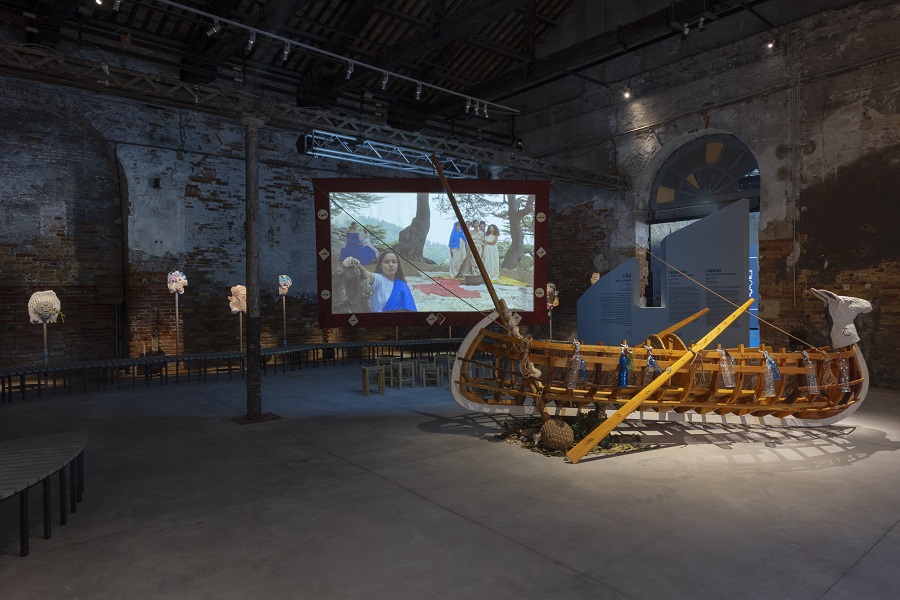
Oman
Oman’s second participation in the biennale, is an exhibition titled “Malath — Haven.” It includes work from five Omani contemporary artists: Ali Al-Jabri, Essa Al-Mufarji, Sarah Al-Aulaqi, Adham Al-Farsi and Alia Al-Farsi (who also curated the show). “We used the word ‘haven’ in the title because, since antiquity, foreigners — including the Romans, Portuguese and Indians — have visited Oman,” Alia Al-Farsi told Arab News. The works on display — from Al-Farsi’s own colorful and expressive mixed-media murals (such as “Alia’s Alleys,” pictured here) to Al-Aulaqi’s “Breaking Bread,” which includes a large sculpture of a niqab made from silver spoons — reflect both traditional and contemporary life in Oman.
“As an Omani creative with an international background, my aim was for the exhibition to serve as a sanctuary for visitors and travelers, allowing stories to unfold and intertwine, mirroring how our country finds its richness in intercultural dialogue,” the curator said in a statement.
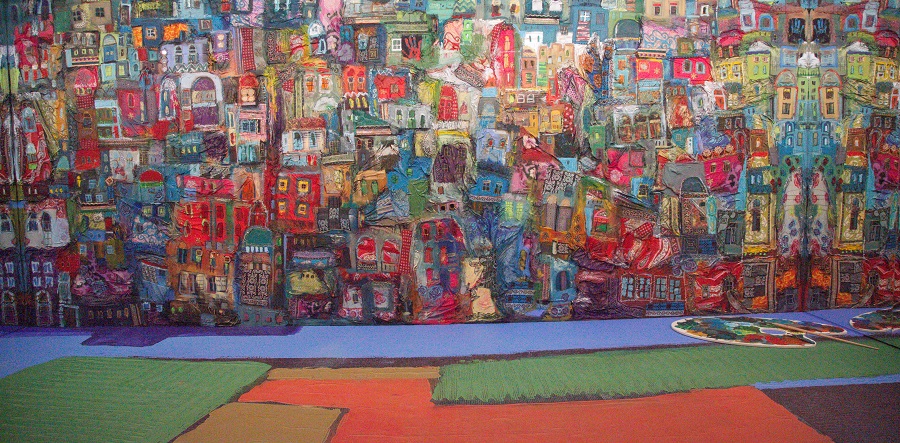
Behind the scenes at Mazen Laham’s Middle East media powerhouse
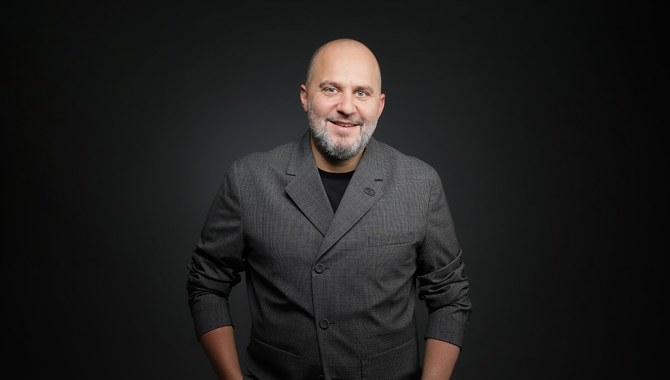
- Mazen Laham’s Different Productions, the company behind “Dubai Bling” and the regional version of “Shark Tank,” just celebrated its 10th anniversary
- Discussing Arabic-language adaptations of global shows, he said they preserve the original concept while respecting cultural sensitivities
DUBAI: Lebanese producer Mazen Laham’s Different Productions celebrated its 10th anniversary this month. The company is one of the driving forces of the television industry in the region, responsible for the creation of acclaimed shows including Netflix’s “Dubai Bling,” and “It’s OK” — a docuseries about the Lebanese pop superstar Elissa — as well as Arabic adaptations of popular franchises “Shark Tank,” “Say Yes to the Dress,” and “Chopped.”
Laham told Arab News that shooting for the third season of “Dubai Bling” has already concluded, adding that it is “even bigger than the two previous seasons.” He confirmed that Emirati-Egyptian TV host Mahira Abdeaziz and Iraqi influencer Jwana Karim will be joining the cast, which already includes Zeina Khoury, Safa and Fahad Siddiqui, DJ Bliss, Danya Mohammed, Kris and Brianna Fade, Mona Kattan Al-Amin, Hassan Al-Amin, Loujain Adada, Ebraheem Al-Samadi, and Farhana Bodi.
The previous two seasons both ranked in the global top 10 for non-English series on Netflix. “I believe in numbers,” Laham said. “It was (popular) globally. What I will say is that season three is a very big season.”
While they suspected the show would be popular, Laham admitted that he and his team were not expecting it to get quite so big. “What we were aiming for is to have a good show but we never thought that it will be this successful,” he said.
The show may be popular, but it has also attracted plenty of criticism online for its depiction of life in Dubai. Laham, though, seems unperturbed.
“We never said that this is Dubai. From day one, we said it is about a group of friends living in Dubai,” he said. “It is not a documentary about the city. We are not saying ‘This is Dubai and this is life in Dubai,’ we only focused on a group of friends living in Dubai.”
Discussing his company’s various Arabic-language adaptations of international shows, Laham said that they try to preserve the original concept of the show while ensuring they cater to the cultural sensitivities and preferences of the region.
“Before getting the shows, we make sure that they fit our culture — anything that, culturally, does not pass, we do not even get it in the first place,” he said. “But, whenever we see something that could be adapted, yes, we (try to) get the rights for it. The most important thing is to keep the structure and the main spirit of the format the same.”
Laham believes there are now two distinct audiences for shows: those for traditional television networks and those for streaming services such as Netflix, Shahid, Starzplay.
“What is on TV does not work on a platform and vice versa, because the new generation want something fast — they want something will keep them hooked. So, it’s very challenging to make content for them,” he said.
What Laham believes works best are docuseries such as “Dubai Bling” and “It’s OK.”
“These are non-scripted, but they are serialized; they’re sticky,” he explained. “You want to keep on watching to follow the stories and this is when you binge watch. On TV channels, you still get to see classical standalone episodes.”
Laham said Different Productions is currently working on an original docuseries for Starzplay called “Unstoppable.”
“It’s a football-based reality show where children between the ages of 13 and 15 compete. There will be one winner, and the winner will hopefully play for one of the big Italian teams,” he said.
Laham described the Saudi Arabia market as “promising,” not only due to the growing number of original productions but also because “the infrastructure, whether it’s Neom or AlUla,” is drawing in creatives from around the world. “I think it’s going to the biggest media hub out there very soon,” he added.
“We care a lot about the viewership in Saudi Arabia because it’s the biggest market,” Laham said. “So we always look into the ratings — even if it’s not a pure Saudi show, we want our shows to be watched in Saudi Arabia.”
Arab-American Heritage Month: Sama Alshaibi — ‘I’m trying to change this idea of what an Arab woman is’
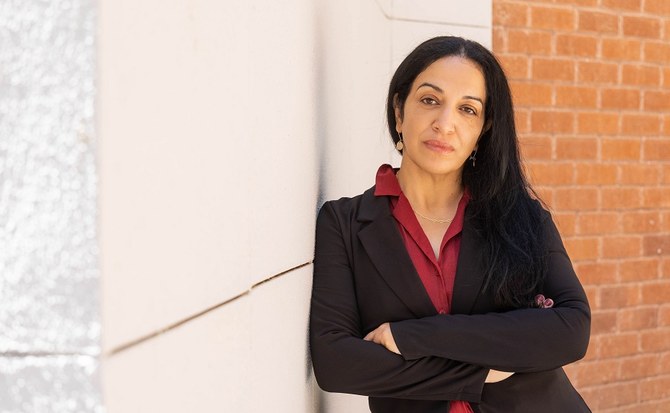
DUBAI: The fourth in this year’s series focusing on contemporary Arab-American artists in honor of Arab-American Heritage Month.
Born in Basrah to an Iraqi father and a Palestinian mother, Sama Alshaibi is an Arizona-based professor and artist who has mostly devoted her 20-year career to video, photography and performance art.
During the Iran-Iraq war of the Eighties, Alshaibi and her family moved around the region, living in Saudi Arabia, the UAE, and Jordan, before eventually settling in the American Midwest when she was 13 years old.
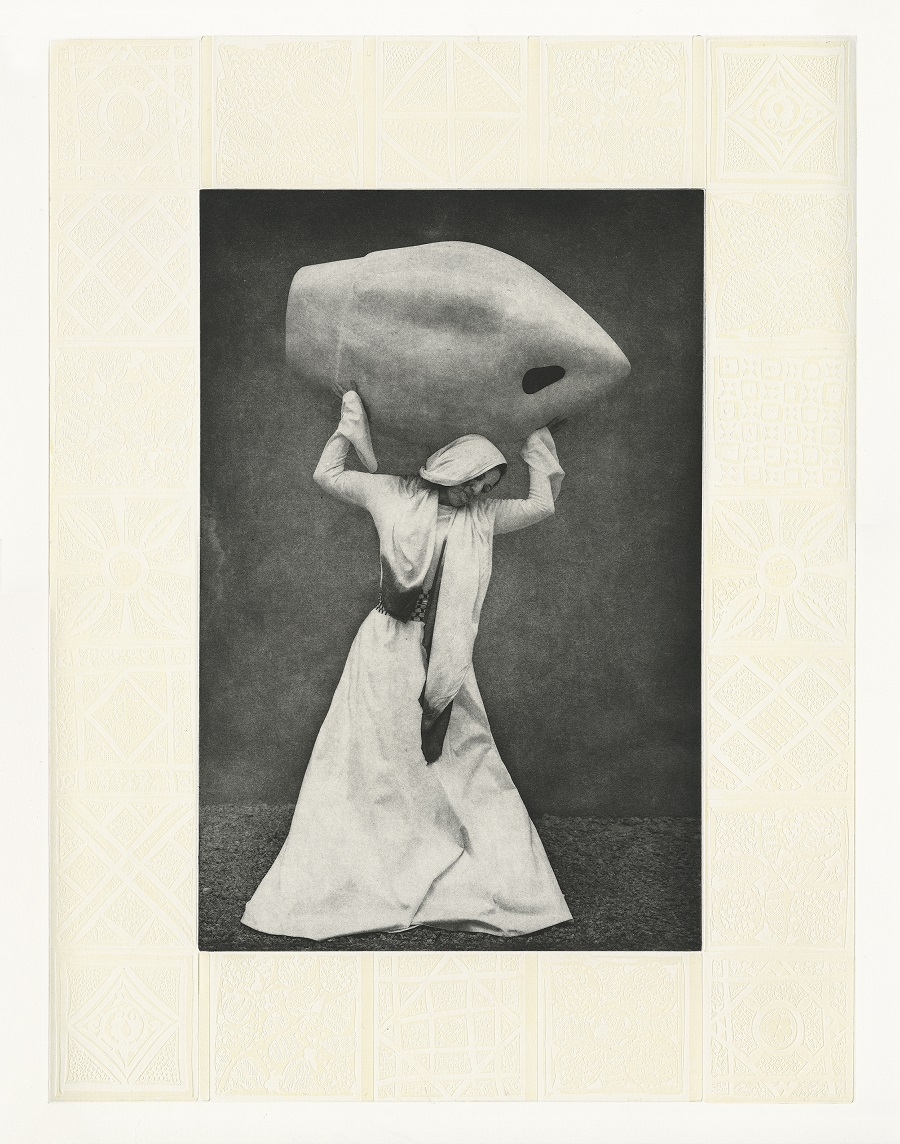
“Growing up in the United States was strange. We were a ‘different’ family in Iowa and there wasn’t a lot of diversity. But I grew up in a place with nice people,” Alshaibi tells Arab News from Bellagio, Italy, where she is doing a residency at the Rockefeller Foundation.
But she also says there were obstacles, mainly formed by major political events that impacted her. “It was challenging, because of where I’m from,” she says.
Alshaibi’s work is largely inspired by her Arab roots. “Arts were so revered in my family,” she says. “I don’t even know if I would be making art if it wasn’t for my heritage.” It was her father, an avid photographer, who taught her to use a manual camera. She aspired to become a photojournalist herself — inspired by 20th-century African-American photographers, notably Carrie Mae Weems and Lorna Simpson, who documented Black culture in their imagery.
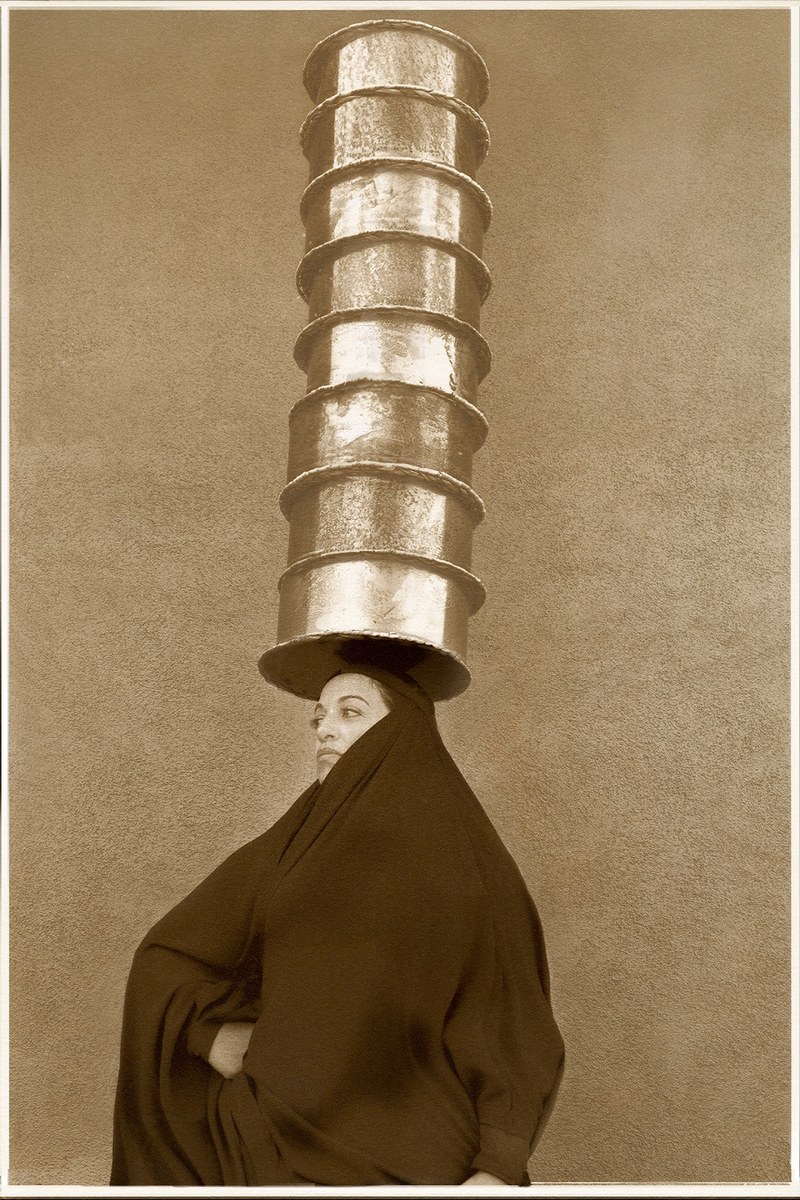
Many of her images are portraits of herself wearing, for example, traditional Middle Eastern garments, referencing romanticized Orientalist portrayals of women, and in the end, challenging them.
“I’m trying to change this idea of what you think an Arab woman is,” she explains. “I started seeing the power of communication, of taking political or social issues and using your body, your performance, your environment, to address them.”
One of Alshaibi’s best-known series is called “Carry Over,” in which she photographed herself carrying large objects (or Orientalist props), such as a tower of container tins or a water vessel, above her head. The images poetically show a woman’s endurance and comment on a collective history, affected by colonialism and cultural loss.
“I’ve always been interested in the notion of ‘aftermath’ — what happens after the destruction of your environment,” explains Alshaibi. “It gets you to the question of what we can’t hold onto anymore.”




